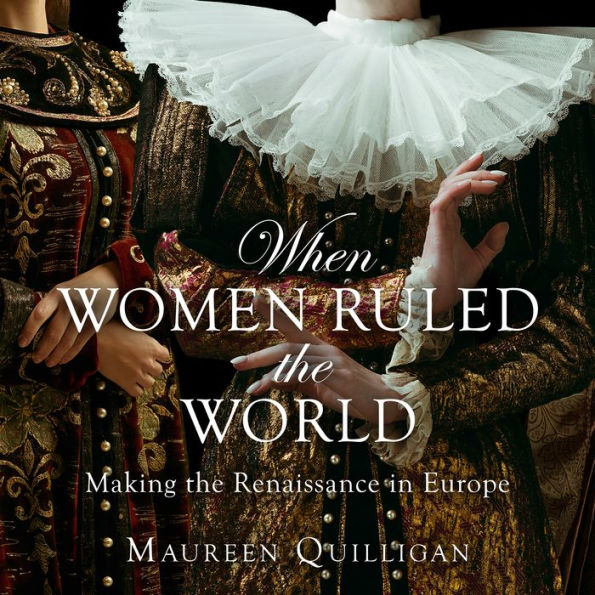Publishers Weekly
08/02/2021
Quilligan (coeditor, Rewriting the Renaissance), a professor of English emerita at Duke, examines in this intriguing survey how female rulers in 16th-century Europe exchanged gifts to strengthen relationships and solidify power. Refuting traditional narratives of “personal jealousy and rancor” between Catherine de’ Medici, Elizabeth I, Mary Tudor, and Mary, Queen of Scots, Quilligan argues that these four queens recognized that they needed to band together to protect against the “looming patriarchal power of the Reformation.” Analyzing 16th-century portraits, Quilligan explains how the inclusion of carefully chosen books and other “inalienable possessions” testified to the wealth and authority of women monarchs. She delves into Elizabeth I’s gift of a solid gold baptismal font to her cousin, Mary Stuart, explaining how it emphasized shared bonds between the Protestant and Catholic queens, and also helped fund Mary’s fight against the rebel Confederate Lords for the Scottish throne. Other items examined include the sumptuous Valois tapestries commissioned by Catherine de’ Medici and passed down to her granddaughter, and the “pear-shaped pendant pearl” worn by Elizabeth I in the 1588 Armada portrait. Quilligan lucidly explains the era’s complex familial, religious, and political dynamics, and draws incisive character sketches. Renaissance buffs will treasure this sparkling revisionist history. (Oct.)
Library Journal
07/16/2021
The 16th century was the era of four of history's most notable female rulers: Catherine de' Medici, Mary I, Elizabeth I, and Mary, Queen of Scots. In this book, Quilligan (English, Duke Univ.; Incest and Agency in Elizabeth's England) aims to look beyond these women's supposed rivalries to explore their alliances and interactions, accenting her analyses with succinct biographical information. The author pays particular attention to the way each woman navigated the prejudice against women in power, and established personal legacies and strengthened bonds through the creation and gifting of "inalienable objects," such as books, jewelry, and tapestries. The choice to highlight connections rather than conflicts is intriguing, and Quilligan's arguments are thought-provoking, though the organization of the text sometimes hampers its impact. The author relies on extensive primary sources and reproduces several portraits of the notable rulers. While the book is divided into sections focusing on the Tudors, the Stuarts, and the Medici, they are all discussed in each section; information and commentary are occasionally repeated, sometimes nearly verbatim, from chapter to chapter. VERDICT An interesting look at the lives and relationships of four of the Renaissance's most powerful women, though general readers might find the focus too scholarly and the arrangement of information somewhat muddled.—Kathleen McCallister, William & Mary Libs., Williamsburg, VA
Kirkus Reviews
2021-07-18
A revisionist history posits warm ties among powerful queens.
Renaissance scholar Quilligan closely examines the relationships among four 16th-century rulers—Mary Tudor, Elizabeth I, Mary Stuart, Queen of Scots, and Catherine de’ Medici—seeking to revise the “misogynist narrative” that placed them in “jealous and warlike opposition” to one another. With meticulous attention to the letters and gifts they exchanged, Quilligan argues that the women nurtured a culture of mutual respect based on their family ties and sense of their “shared nature of power.” Their lives were inextricably intertwined: Mary Tudor and Elizabeth were half sisters and religious antagonists; Mary Stuart was their cousin once removed; Catherine, though not a queen, was Mary Stuart’s mother-in-law and “ruled as mother of three different kings.” Considering Elizabeth’s relationship with Mary Stuart, Quilligan asserts that the Protestant and Catholic queens evinced “an essentially similar, tolerant Christianity”—unlike Catholic Mary Tudor, who, during the first three years of her reign, “burned heretics alive, many of them common people but some of them Anglican bishops and archbishops.” Elizabeth accepted Mary Stuart’s request to be godmother to her son James and sent a solid gold baptismal font upon the boy’s birth, symbolizing the queens’ mutual desire for “unity and toleration.” Still, Mary soon melted it down to fund her troops. Other gifts among the women included gems, silver, fine embroidery, books, and tapestries; as Quilligan notes, many of Elizabeth’s 800 pieces of jewelry were gifts from women, not necessarily family. Elizabeth and her cousin never met, even when Mary Stuart, perceived by Elizabeth’s courtiers as a threat, lived for more than 18 years under house arrest in England. When Mary Stuart was beheaded in 1587, Elizabeth, furious, claimed the execution was a “miserable accident” about which she had known nothing. At times, it is difficult to separate the rulers’ political exigency from their familial loyalty, but the book is a useful addition to the literature on European royalty.
An authoritative and sympathetic collective biography.



